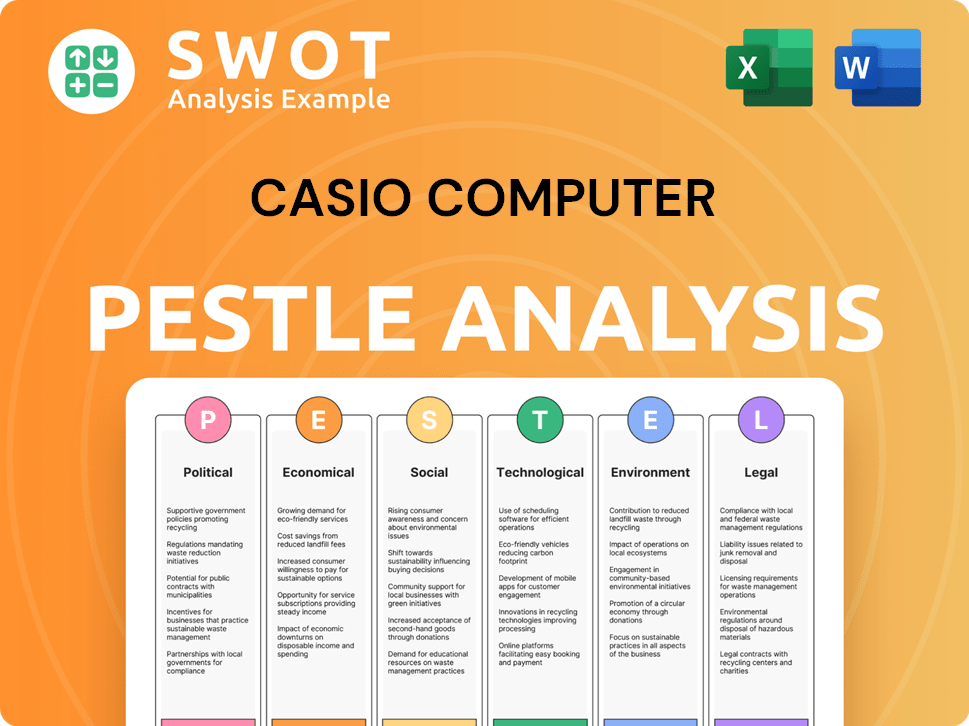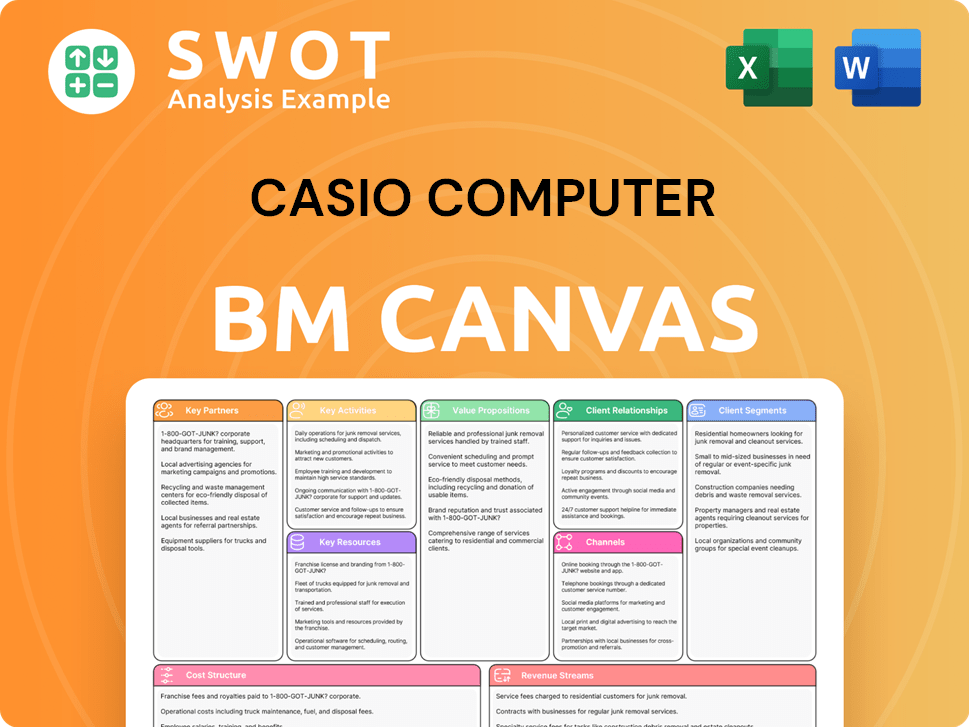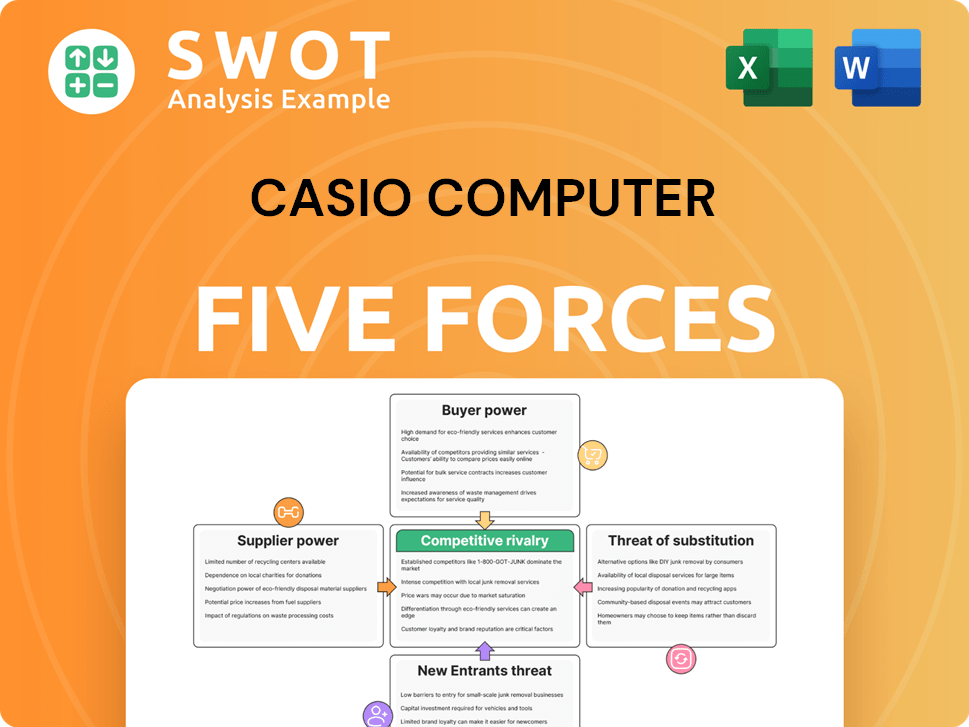Casio Computer Bundle
How did Casio Computer Company go from a small workshop to a global electronics giant?
Imagine a company born from a vision to revolutionize everyday technology, starting with a groundbreaking innovation. Casio Computer Company's story is one of relentless creativity and adaptation, transforming from a small workshop in post-war Japan to a global powerhouse. Their journey is a testament to the power of innovation and a commitment to meeting evolving consumer needs.

Founded in April 1946 as Kashio Seisakujo, the Casio Computer SWOT Analysis reveals a company deeply rooted in the principles of innovation. From its early days and the vision of the Casio founder, Tadao Kashio, to its current status, Casio's history is marked by significant milestones. The early days of Casio Computer Co. saw the development of groundbreaking products, which set the stage for its future dominance in the electronics industry. This exploration of Casio's timeline will delve into the key moments that shaped the company.
What is the Casio Computer Founding Story?
The story of Casio Computer Company, a global electronics giant, begins in post-World War II Japan. The company's founding is a tale of innovation, resilience, and the vision of one man, Tadao Kashio. This journey from a small workshop to a multinational corporation showcases the company's commitment to creativity and contribution.
In April 1946, Tadao Kashio established Kashio Seisakujo in Mitaka, Tokyo. His initial focus was on fabrication technology, but the economic realities of the time shaped his first successful product. This early venture laid the groundwork for Casio's future, highlighting the importance of adapting to market needs.
The Owners & Shareholders of Casio Computer have a long and interesting history. In 1949, Tadao and his brothers were inspired by the first commercial electric calculators. This pivotal moment steered the company towards the development of calculators, setting the stage for Casio's future in the electronics industry.
Casio's early days were marked by innovation and a focus on practical solutions. The company's first product, the 'yubiwa pipe,' was a financial success, providing the capital needed for future ventures.
- 1946: Tadao Kashio establishes Kashio Seisakujo.
- 1949: The Kashio brothers are inspired by electric calculators.
- 1954: They complete Japan's first electro-mechanical calculator.
- 1957: Casio Computer Co., Ltd. is formally incorporated.
Tadao Kashio, born in 1917, initially focused on the 'yubiwa pipe,' a finger ring designed to hold a cigarette. This invention was successful due to the high value of cigarettes in post-war Japan. The profits from this product provided the resources necessary to pursue the development of calculators.
The true turning point came in 1949 when Tadao and his brothers witnessed the commercial presentation of electric calculators. Recognizing the potential, they used their resources to develop their own calculators. Toshio Kashio, with his electronics knowledge, led the effort, resulting in Japan's first electro-mechanical calculator in 1954. This desk-sized machine was a significant achievement.
In June 1957, Casio Computer Co., Ltd. was formally incorporated. The company's initial aim was to develop and manufacture these relay-driven calculators. The company's name, initially written in Japanese kanji, later transitioned to katakana as the brand gained popularity. The Kashio brothers, including Tadao, Toshio, Kazuo, and Yukio, played key roles in the company's management, with their father, Shigeru, serving as president. The company's philosophy, 'creativity and contribution,' was established from these early steps, emphasizing a commitment to innovation and meeting people's needs.
Casio Computer SWOT Analysis
- Complete SWOT Breakdown
- Fully Customizable
- Editable in Excel & Word
- Professional Formatting
- Investor-Ready Format

What Drove the Early Growth of Casio Computer?
The early years of Casio Computer Company were marked by rapid growth and significant innovation. The company's initial success was driven by its pioneering work in calculators, which quickly gained traction in the business world. This period saw Casio expanding its product lines and global reach, laying the foundation for its future as a diversified electronics manufacturer.
In June 1957, after its formal establishment, Casio launched the Model 14-A, the world's first compact all-electric calculator based on relay technology. This machine, initially priced at ¥485,000, was a significant advancement. Later, in September 1965, the company introduced the 001 electronic desktop calculator with onboard memory, followed by the AL-1000, the world's first programmable electronic desktop calculator with a program, in October 1967.
Casio began its global expansion in September 1966 with the first exports of electronic desktop calculators to Australia. European offices were established in Zurich, Switzerland (March 1967), and Hamburg, Germany (June 1969). The company entered the US and Canadian markets through an OEM partnership with Commodore in September 1967. The Kofu Factory was completed in October 1969, enhancing manufacturing capabilities.
The launch of the Casio Mini in 1972 marked a pivotal moment, with a million units sold in the first 10 months and a total of 10 million. This success allowed Casio to diversify. The Casiotron watch, introduced in 1974, featured the world's first automatic calendar function. By 1978, the 'credit card' calculator (the LC-78) was introduced.
In 1980, Casio entered the electronic musical instrument market with the Casiotone 201, selling over 1 million keyboards by 1983. The company began moving much of its manufacturing outside of Japan in the late 1980s to maintain cost-competitiveness. These strategic expansions and product diversifications, coupled with aggressive marketing and sales strategies, enabled Casio to sell its products in over 140 countries, shaping its trajectory from a calculator manufacturer to a diversified consumer electronics company. For more details, consider this article about Casio Computer Company.
Casio Computer PESTLE Analysis
- Covers All 6 PESTLE Categories
- No Research Needed – Save Hours of Work
- Built by Experts, Trusted by Consultants
- Instant Download, Ready to Use
- 100% Editable, Fully Customizable

What are the key Milestones in Casio Computer history?
The Casio Computer Company has a rich Casio history marked by significant achievements that have shaped the consumer electronics landscape. From its early days, the company has consistently introduced groundbreaking products, establishing itself as a leader in innovation and design. The Casio timeline showcases the company's adaptability and its ability to anticipate and meet evolving consumer needs, solidifying its place in the industry.
| Year | Milestone |
|---|---|
| 1957 | Introduced the Model 14-A, the world's first compact all-electric calculator. |
| 1972 | Launched the Casio Mini, making calculators accessible to the mass market. |
| 1974 | Entered the digital watch market with the Casiotron, the world's first wristwatch with an automatic calendar function. |
| 1980s | Became a pioneer in electronic musical instruments with the Casiotone series. |
| 1983 | Introduced the G-SHOCK watch, setting a new standard for durability and functionality. |
| 1995 | Launched the QV-10, one of the first consumer digital cameras with an LCD display. |
Casio has consistently pushed the boundaries of technology, introducing innovative Casio products that have redefined various sectors. The company's commitment to research and development has resulted in numerous patents and groundbreaking designs. The company’s ability to integrate cutting-edge technology into user-friendly products has set it apart in the competitive electronics market, as detailed in Marketing Strategy of Casio Computer.
The introduction of the Model 14-A in 1957 marked a significant advancement in calculator technology, making calculations faster and more accessible. The Casio Mini further democratized the technology, making calculators affordable and available to a wider audience.
The Casiotron, launched in 1974, was the world's first wristwatch with an automatic calendar function, setting a new standard for timekeeping. The G-SHOCK, introduced in 1983, revolutionized the watch industry with its durability and functionality.
The Casiotone series of electronic musical instruments made music creation more accessible to a broader audience. These instruments were innovative in their ease of use and affordability, expanding the market for electronic music.
Casio's introduction of the QV-10 in 1995, one of the first consumer digital cameras with an LCD display, and the EX-S1 in 2002, a business-card sized digital camera, showcased the company's commitment to innovation in digital imaging. These cameras made digital photography more accessible and convenient.
The G-SHOCK watch, launched in 1983, became a cultural phenomenon, known for its rugged design and durability. It has maintained its popularity, evolving with new features and designs to stay relevant.
Casio has consistently integrated new technologies into its products, from calculators and watches to musical instruments and cameras. This has allowed the company to stay at the forefront of consumer electronics.
Despite its successes, Casio has faced several challenges, including the rapid evolution of technology and changing consumer preferences. The decline in demand for traditional products, such as digital cameras and electronic dictionaries, has significantly impacted the company. In February 2025, Casio announced it would cease developing new electronic dictionary models due to decreasing demand.
The rise of smartphones has significantly impacted the demand for traditional products like digital cameras and electronic dictionaries. This shift has forced Casio to adapt and seek new market opportunities.
Intense competition in the consumer electronics market has put pressure on Casio's profitability. The company has had to innovate continuously to maintain its market position.
A ransomware attack in October 2024 disrupted operations, impacting financial results for fiscal year 2025. This event highlighted the need for robust cybersecurity measures.
The company reported a 32.3% decrease in profit attributable to owners for the fiscal year ended March 31, 2025, despite relatively flat revenues. This was partly due to the challenges mentioned above.
Casio has undertaken strategic pivots and restructuring efforts, including optimizing its personnel structure and reforming its organizational culture. These efforts aim to strengthen its profit base.
The company is focusing on core businesses like timepieces and exploring new business domains like mental wellness. This strategic shift aims to leverage existing technological assets and adapt to changing market dynamics.
Casio Computer Business Model Canvas
- Complete 9-Block Business Model Canvas
- Effortlessly Communicate Your Business Strategy
- Investor-Ready BMC Format
- 100% Editable and Customizable
- Clear and Structured Layout

What is the Timeline of Key Events for Casio Computer?
The Casio Computer Company boasts a rich Casio history marked by innovation and strategic pivots. From its inception as Kashio Seisakujo in April 1946, founded by Tadao Kashio, to its current position, the company has consistently redefined its product offerings. The company's journey includes breakthroughs in calculators, watches, musical instruments, and digital cameras, reflecting a commitment to 'creativity and contribution.'
| Year | Key Event |
|---|---|
| April 1946 | Kashio Seisakujo founded in Mitaka, Tokyo, by Tadao Kashio. |
| June 1957 | Casio Computer Co., Ltd. established; Model 14-A, the world's first compact all-electric calculator, released. |
| September 1965 | Release of the 001 electronic desktop calculator with onboard memory. |
| October 1967 | Introduction of the AL-1000, the world's first programmable electronic desktop calculator. |
| 1972 | Launch of the Casio Mini, a personal calculator that sold millions. |
| 1974 | Entry into the digital watch market with the Casiotron, the world's first wristwatch with an automatic calendar. |
| 1980 | Casio enters the electronic musical instrument market with the Casiotone 201. |
| 1983 | Launch of the iconic G-SHOCK watch. |
| 1995 | Introduction of the QV-10, one of the first consumer digital cameras with an LCD display. |
| October 2024 | Casio experiences a ransomware attack impacting systems and operations. |
| February 2025 | Casio announces it will stop developing new electronic dictionary models and streamline its electronic musical instrument business. |
| March 2025 | Casio America announces a strategic transformation, including headquarters relocation and new operations and distribution centers. |
| May 2025 | Casio reports consolidated net sales of ¥261.7 billion for the fiscal year ended March 31, 2025, and operating income of ¥14.2 billion. |
Casio is undergoing a strategic transformation, focusing on structural reform and strengthening its profit base. This includes a Medium-Term Management Plan (FY2024-FY2026) to drive innovation and growth. The company aims to expand popular watch models through e-commerce and launch direct e-commerce exclusive models.
For the fiscal year ended March 31, 2025, Casio reported consolidated net sales of ¥261.7 billion and operating income of ¥14.2 billion. The company is aiming for a moderate operating margin expansion, from 5.3% in fiscal 2023 to an expected 10.5% in fiscal 2028. These figures highlight the company's financial health and future goals.
Casio is exploring new business domains, including mental wellness, leveraging its existing technologies. The company is focusing on creating new experience value using new technologies within their musical instrument business. This diversification strategy reflects Casio’s adaptability.
Analyst predictions suggest Casio’s earnings growth is forecast at 16.3% per year, exceeding the US market's 14.4% per year. Revenue growth is projected to be slower at 1.6% per year. These projections indicate positive expectations for Casio's future performance.
Casio Computer Porter's Five Forces Analysis
- Covers All 5 Competitive Forces in Detail
- Structured for Consultants, Students, and Founders
- 100% Editable in Microsoft Word & Excel
- Instant Digital Download – Use Immediately
- Compatible with Mac & PC – Fully Unlocked

Related Blogs
- What is Competitive Landscape of Casio Computer Company?
- What is Growth Strategy and Future Prospects of Casio Computer Company?
- How Does Casio Computer Company Work?
- What is Sales and Marketing Strategy of Casio Computer Company?
- What is Brief History of Casio Computer Company?
- Who Owns Casio Computer Company?
- What is Customer Demographics and Target Market of Casio Computer Company?
Disclaimer
All information, articles, and product details provided on this website are for general informational and educational purposes only. We do not claim any ownership over, nor do we intend to infringe upon, any trademarks, copyrights, logos, brand names, or other intellectual property mentioned or depicted on this site. Such intellectual property remains the property of its respective owners, and any references here are made solely for identification or informational purposes, without implying any affiliation, endorsement, or partnership.
We make no representations or warranties, express or implied, regarding the accuracy, completeness, or suitability of any content or products presented. Nothing on this website should be construed as legal, tax, investment, financial, medical, or other professional advice. In addition, no part of this site—including articles or product references—constitutes a solicitation, recommendation, endorsement, advertisement, or offer to buy or sell any securities, franchises, or other financial instruments, particularly in jurisdictions where such activity would be unlawful.
All content is of a general nature and may not address the specific circumstances of any individual or entity. It is not a substitute for professional advice or services. Any actions you take based on the information provided here are strictly at your own risk. You accept full responsibility for any decisions or outcomes arising from your use of this website and agree to release us from any liability in connection with your use of, or reliance upon, the content or products found herein.